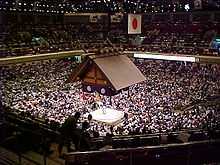Honbasho
A honbasho (本場所) is an official professional sumo tournament. There are six held each year, a system established in 1958. Only honbasho results matter in determining promotion and relegation for rikishi (sumo wrestlers).

A literal translation of honbasho is "main (or real) tournament". This term is used to distinguish these tournaments from display basho which are held as part of sumo tours, between the six major tournaments. Such display tournaments may have prize money attached but a wrestler's performance has no effect on his ranking. This type of sumo is often called hana-sumo (lit. flower-sumo) as it is not taken as seriously by the wrestlers.

Honbasho last for 15 days. Sumo wrestlers ranked in the top two divisions (makuuchi and jūryō) wrestle once each day, while those of the lower divisions wrestle seven times, approximately once every alternate day.
The first aim for most wrestlers is to achieve kachikoshi, or a majority of wins, and thus ensure a promotion for the next tournament. In addition for each division there is a championship prize (yūshō) for the wrestler with the most wins at the end. A playoff on the final day is used to decide the winner in case of a tie.
Unless a playoff is required, two wrestlers will fight each other no more than once in a whole tournament. The bout schedule is set by a committee of sumo elders a day or two in advance of a tournament day, and may be announced from the dohyō the day prior by a senior gyōji. Although there is no fixed method, for the first half of a tournament the top makuuchi division will generally pair the top maegashira ranks against the san'yaku wrestlers, with the rest of maegashira fighting among ranks closer in strength. The schedule second half of the tournament will have mainly san'yaku fighting each other, with the remainder of the ranks determined by their win-loss records up to that point. One consideration is to minimize the necessity for a tiebreaker bout, particularly if a contender for the yūshō is lower-ranked and has thus far faced only other lower-ranked wrestlers.
Outside playoff bouts, neither wrestlers from the same heya nor wrestlers related by blood are scheduled to fight each other.
For jūryō and below, the first half of a tournament will have wrestlers of similar rank competing against each other, while the second half will be determined by win-loss records.
A bye is only possible if a wrestler has withdrawn due to injury after the bout schedule for a day is already set, in which case his opponent wins by forfeit. Otherwise, if a withdrawal results in an odd number of wrestlers in one division, the schedule is filled in by pairing a lower-ranked wrestler against a higher-ranked wrestler from the next-lower division.
| Honbasho | Nickname | City | Venue | Opening Day |
|---|---|---|---|---|
| January | Hatsu (Opening) Basho | Tokyo | Ryōgoku Kokugikan | 1st or 2nd Sunday |
| March | Haru (Spring) Basho | Osaka | Osaka Prefectural Gymnasium | 2nd Sunday |
| May | Natsu (Summer) Basho | Tokyo | Ryōgoku Kokugikan | 2nd Sunday |
| July | Nagoya Basho | Nagoya | Aichi Prefectural Gymnasium | 1st or 2nd Sunday |
| September | Aki (Autumn/Fall) Basho | Tokyo | Ryōgoku Kokugikan | 2nd Sunday |
| November | Kyūshū Basho | Fukuoka | Fukuoka Kokusai Center | 2nd Sunday |
The March tournament in 2011 was cancelled due to the Sumo Association launching an investigation into allegations of match-fixing involving several sekitori ranked wrestlers. This was the first cancellation of a honbasho since 1946, when the summer tournament was not held because of renovations to the Kokugikan following damage sustained in World War II. The May 2011 tournament went ahead, but was described by the Japan Sumo Association as a "technical examination" tournament rather than a fully fledged honbasho, with tickets given away free in a lottery, and no prize money or trophies awarded.
See also
- List of sumo record holders
- List of sumo tournament top division champions
- List of sumo tournament second division champions
External links
- Honbasho schedule from the Japan Times.